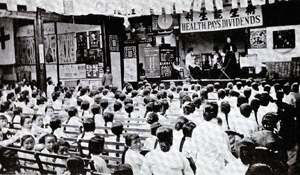Education
Higher Education Modules
Disseminating Health Knowledge: Public Health Campaigns in 20th-Century China
Class 2: First Public Health Campaigns and New Meanings of Health in China
Introduction
The modern concept of public health as we understand it did not exist in China until doctors of Western medicine started promoting it at the turn of the 20th century. The first modern public health education campaigns were launched in China in the 1910s when the country was undergoing a difficult process of transformation from a traditional society into a modern nation. The Joint Council on Public Health Education, sponsored by Chinese physicians trained in Western medicine, the YMCA, and medical missionaries, led the campaigns in cities in different provinces. These groups promoted Western medicine and public health in the name of progress and modernization of China, despite their different agendas. Like the campaigns in the West, the Chinese ones made extensive use of graphic illustrations to convey health information. They included maps, charts, diagrams, cartoons, paintings, pictures, placards, tracts and epigrams, as well as lantern slides and large mechanical and electrical devices. The Chinese public were at first indifferent to the talk of “Health Pays Dividends” and death rates; and they were rather suspicious about the motives of the campaigns until the lectures of the campaigns began to link the importance of public health with national strength. In the transfer of Western health campaign techniques and strategies to China, the meanings of public health changed in the Chinese context.
Readings
Bu, Liping. “Public Health and Modernization: The First Campaigns in China, 1915-1916,” Social History of Medicine 22.2 (2009): 305-319. http://shm.oxfordjournals.org/content/22/2/305.full.pdf
Bu, Liping. “Cultural Communication in Picturing Health: W. W. Peter and Public Health Campaigns in China, 1912-1926.” Imagining Illness: Public Health and Visual Culture. Edited by David Serlin. University of Minnesota Press, 2010, pp. 24-39.
Strother, French. 1918. “An American Physician-Diplomat in China,” The World’s Work 35. New York: Doubleday, Page & Co., 1918, pp. 545-555. On Google books.
Winslow, C.-E. A. The Evolution and Significance of the Modern Public Health Campaign, New Haven: Yale University Press, 1923.
Discussion Questions:
- Discuss the shift of meanings of public health when Western-style health campaigns were conducted in China.
- What were the purposes of the Chinese health campaigns? How did the Chinese urban public react to the campaigns?
- How did the Chinese government respond to the campaigns? What did the government try to achieve?
- In what terms did the campaigns connect the health of individuals to the strength of the nation?
- Pay attention to the images in the articles of “Public Health and Modernization” (Bu) and “An American Physician-Diplomat” (Strother), and explain how these health images changed over time to become culturally more “authentic” to the Chinese audience. How was the germ theory introduced to the Chinese public via the health images?
Women’s Day at a Health Campaign, ca. 1915.
Source: Peter, W. W. Broadcasting Health in China: the Field and Methods of Public Health Work in the Missionary Enterprise. Shanghai: Presbyterian Mission Press, 1926, p. 24.



